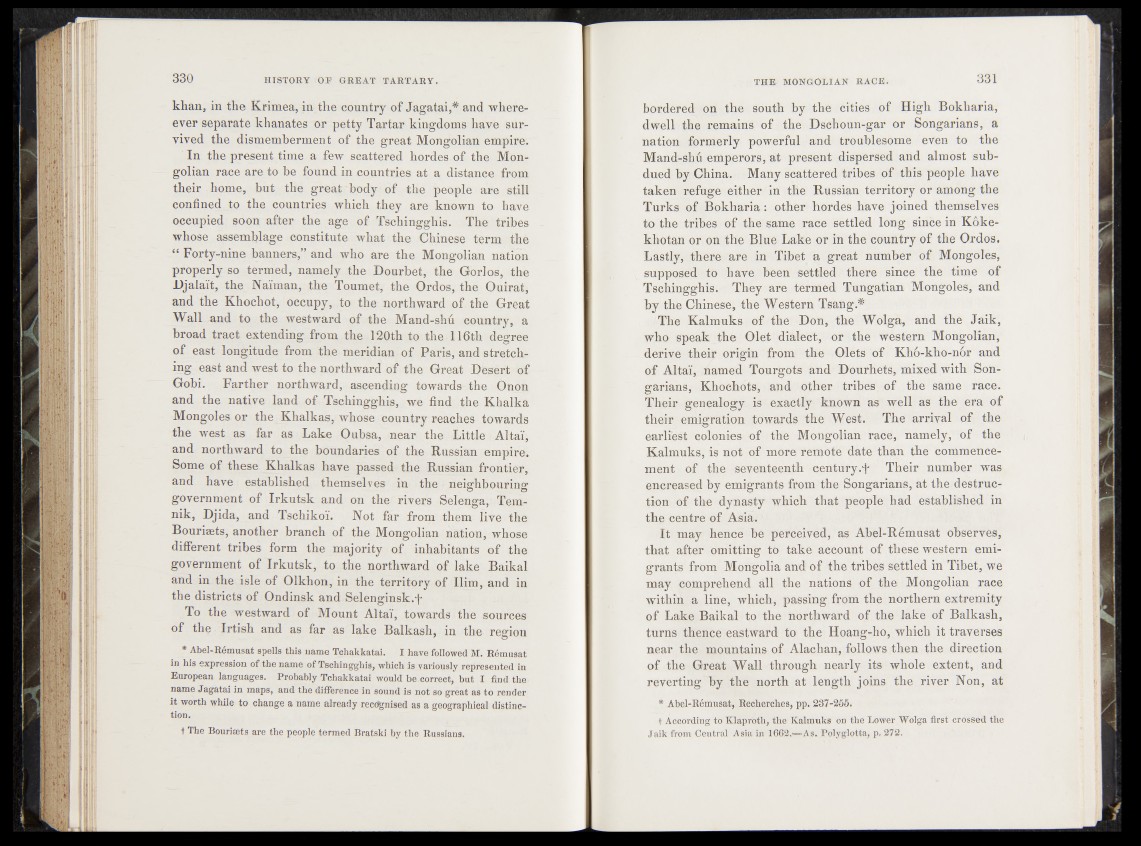
khan, in the Krimea, in the country of Jagatai,* and where-
ever separate khanates or 'petty Tartar kingdoms have survived
the dismemberment of the great Mongolian empire;
In the present time a few scattered hordes of the Mongolian
race are to be found in countries at a distance from
their home, but the great body of the people are still
confined to the countries which they are known to ha&e
occupied soon after the age of Tschingghis; The tribes
whose assemblage constitute what the Chinese term the
“ Forty-nine banners,” and who are the Mongolian nation
properly so termed, namely the Dourbet, the Qorlos, the
Djalaït, the Naïman, the Toumet, the Ordos, the Ouirat;
and the Khochot, occupy, .to the northward of the Great
Wall .and to the westward of the Mand-shu country, a
broad tract extending from the 120th to the 116th dogbee
of east longitude from the meridian of Paris, and.stretch*
ing east and west to the northward of the Great Dfesliife -bf
Gobi. Farther northward, ascending towards-the Cnon
and the native land of Tschingghis, we find ithe Khalka
Mongoles or the Khalkas, whose country reaches-Ltowards
the west as far as Lake Oubsa, near the Little Altaï;
and northward to the boundaries of the Russian empire.
Some of these Khalkas have passed the Russian frontier,
and have established themselves in the • neighbouring
government of Irkutsk and on the rivers Selenga,-Tem-
nik, Djida, and Tsehikoï. Not far from them- live ; the
Bourisets, another branch of the Mongolian nation, whose
different tribes form the majority of inhabitants of the
government of Irkutsk, to the northward of lake Baikal
and in the isle of Olkhon, in the territory of Ilim, and in
the districts of Ondinsk and Selenginsk.f
To the westward of Mount Altaï, towards the sources
of the Irtish and as far as lake Balkash, in the region
* Abel-Rémusat spells this name Tchakkatai. I hare followed M. Rémusat
in his expression of the name of Tschingghis, which is variously represented in
European languages. Probably Tchakkatai would be.correct, but I find the
name Jagatai in maps, and the difference in sound is not so gréât as to render
it worth while to change a name already recognised as a geographical distinction.
t The Bourisets are the people termed Bratski by the Russians.
bordered-mri the» south (by; :the; pities of High Bokharia,
dwell « the, rem a in of* the Dschoun-gar or Songarians, a
natiom.fforme^^ powerful and troublesome even to the
Mand^iM,emperors, at present dispersed.arid almost subdued*
by China. Many scattered‘tribes of ,<this people have
taken refuge either»" in the Russiumtemtory o r among the
Turks of Bokharia: other hordes have joined themselves
to the tribes of fhefsame race Settled long sinee in Kfike-
khotan or on the Blue Lake or in the country of the Ordos.
Lh'sifly, there are fin Tibet a great number of Mongoles,
supposedMto have;?b^j§n rsdttlfed;' there fsihee J the time of
Tschingghis.- They^re termed Tungatian Mongoles, and
by the Chinese; ».the Westerri- Tsarig.#
-The Kalmuks of the5 -©Oh, the Wolga, and the Jaik,
who speak the Olet^dialect, or \fhe - westej^' Mongolian,
derive their origin from - the .Qlets ^ojf Kho-kho-n6r and
of Altai, .named Tourgots and Dourh<#k mixed with1 Sori-
garians, KhoOhots, and otherr|^pR|dsVof<*th'0 :same race.
Their genealogy is exactly known as! well as‘* ^he.- era of
their emigration towards N$Kh '»WWsid The arrival of the
earlieft colonios^of^ the Mohjgblirim:ra<3#, namely,' ofV. the
Kalmuks, is noi/of more remote date than the commence?
ment of the ^seventeenth century.'! Their number was
encreased by emigrants from thedSongarians, at the destruction
of the dynasty which that people had established in
the centre of Asia. •
It may hence be perceived, as Ab’el-Reinusat observes,
that after omitting to take account of these western emi£
grants from Mongolia and'of the tribeS settled in Tibet, we
may comprehend all the nations of the; Mongolian race
within a line, which, passing from the northernextremity
of Lake Baikal to the berth ward of the lake of Balkash,
turns thence eastward to the Hoang«ho, which it traverses
near the mountains of, Alachan, follows then the direction
of the Great Wall through nearly its whole extent, and
reverting by the north at length joins the river Non, at
* Abel-R6musat,. Recberches, pp. 287-265. -
t According to Klaproth, the Kalmuks on this Lower Wolga first crossed the
Jaik from Central Asia in 1662.1—As. Polyglotta, p. 272.